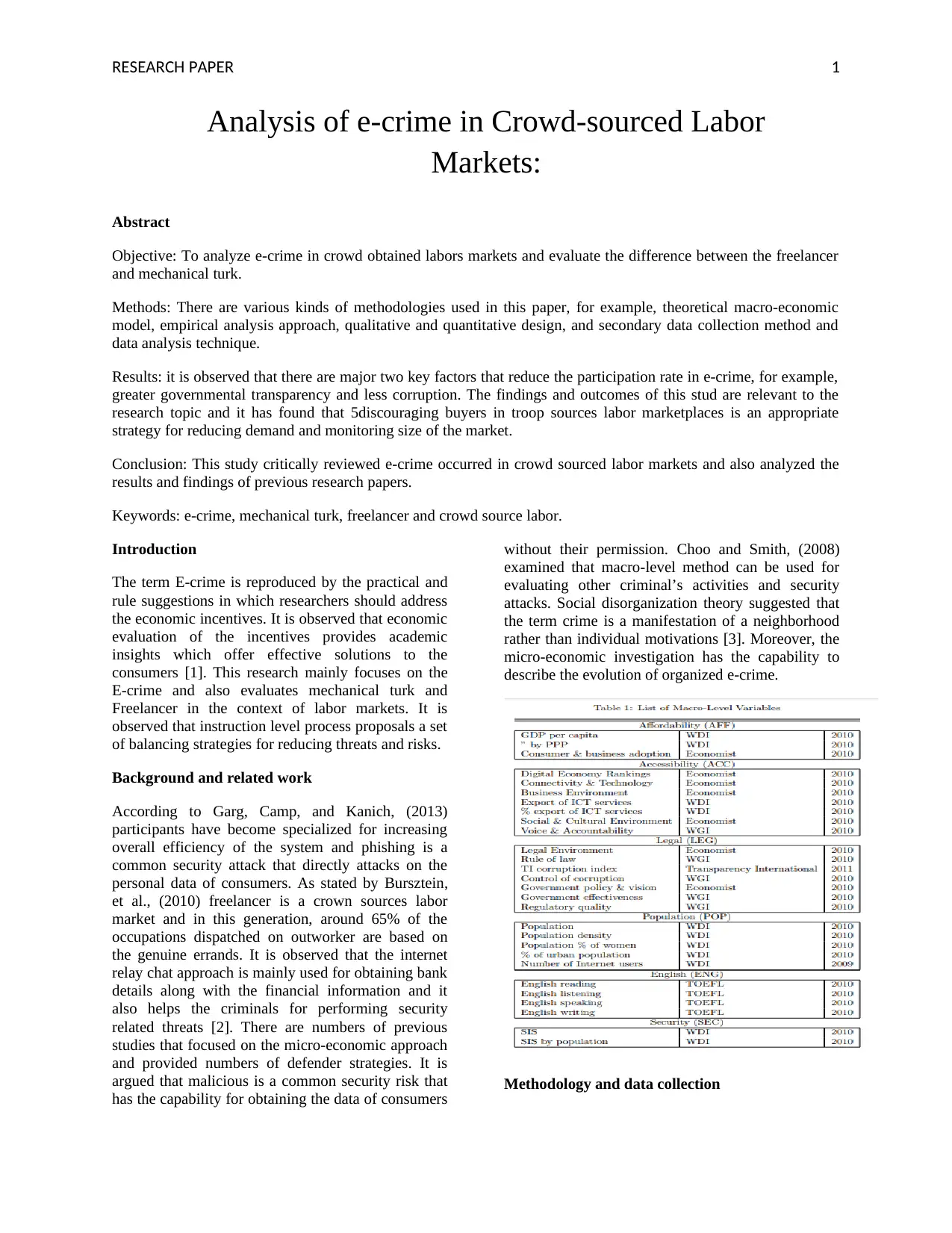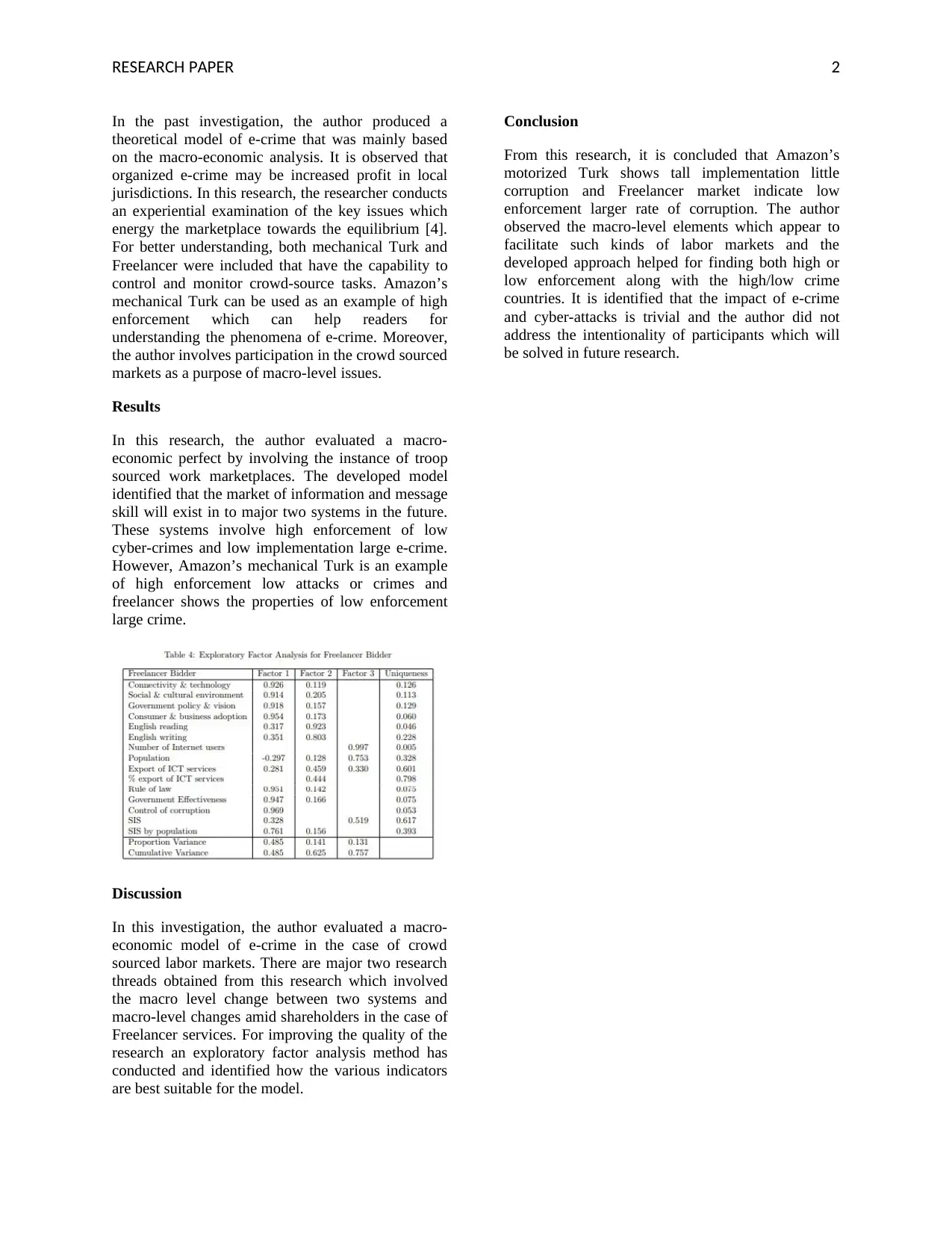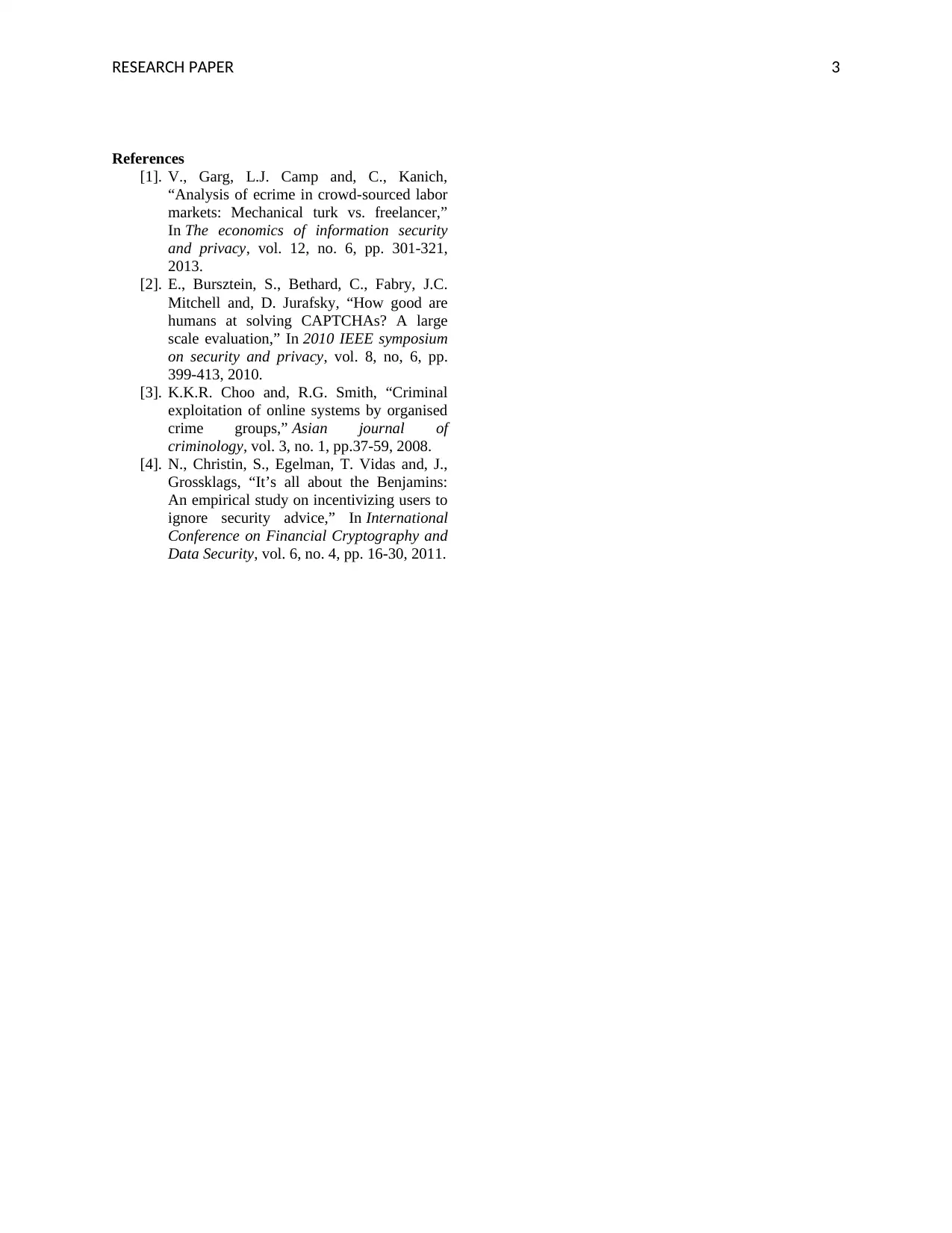CSCI 690 Research Project: E-crime in Crowd-sourced Labor Markets
VerifiedAdded on 2022/11/25
|3
|1102
|228
Report
AI Summary
This research paper, focusing on e-crime within crowd-sourced labor markets, critically examines and compares Mechanical Turk and Freelancer platforms. The study employs various methodologies including macroeconomic modeling, empirical analysis, and data collection to assess the factors influencing e-crime participation. Key findings highlight that governmental transparency and reduced corruption significantly decrease e-crime rates. The research also suggests that discouraging buyers in crowd-sourced labor markets is an ineffective strategy for reducing demand. The paper reviews previous research, analyzes the implications of e-crime, and identifies the differences between Mechanical Turk and Freelancer in terms of enforcement and crime rates. The conclusion emphasizes the importance of macro-level elements in shaping these labor markets and acknowledges the limitations of the study, particularly regarding the intentionality of participants, which will be addressed in future research.

RESEARCH PAPER 1
Abstract
Objective: To analyze e-crime in crowd obtained labors markets and evaluate the difference between the freelancer
and mechanical turk.
Methods: There are various kinds of methodologies used in this paper, for example, theoretical macro-economic
model, empirical analysis approach, qualitative and quantitative design, and secondary data collection method and
data analysis technique.
Results: it is observed that there are major two key factors that reduce the participation rate in e-crime, for example,
greater governmental transparency and less corruption. The findings and outcomes of this stud are relevant to the
research topic and it has found that 5discouraging buyers in troop sources labor marketplaces is an appropriate
strategy for reducing demand and monitoring size of the market.
Conclusion: This study critically reviewed e-crime occurred in crowd sourced labor markets and also analyzed the
results and findings of previous research papers.
Keywords: e-crime, mechanical turk, freelancer and crowd source labor.
Introduction
The term E-crime is reproduced by the practical and
rule suggestions in which researchers should address
the economic incentives. It is observed that economic
evaluation of the incentives provides academic
insights which offer effective solutions to the
consumers [1]. This research mainly focuses on the
E-crime and also evaluates mechanical turk and
Freelancer in the context of labor markets. It is
observed that instruction level process proposals a set
of balancing strategies for reducing threats and risks.
Background and related work
According to Garg, Camp, and Kanich, (2013)
participants have become specialized for increasing
overall efficiency of the system and phishing is a
common security attack that directly attacks on the
personal data of consumers. As stated by Bursztein,
et al., (2010) freelancer is a crown sources labor
market and in this generation, around 65% of the
occupations dispatched on outworker are based on
the genuine errands. It is observed that the internet
relay chat approach is mainly used for obtaining bank
details along with the financial information and it
also helps the criminals for performing security
related threats [2]. There are numbers of previous
studies that focused on the micro-economic approach
and provided numbers of defender strategies. It is
argued that malicious is a common security risk that
has the capability for obtaining the data of consumers
without their permission. Choo and Smith, (2008)
examined that macro-level method can be used for
evaluating other criminal’s activities and security
attacks. Social disorganization theory suggested that
the term crime is a manifestation of a neighborhood
rather than individual motivations [3]. Moreover, the
micro-economic investigation has the capability to
describe the evolution of organized e-crime.
Methodology and data collection
Analysis of e-crime in Crowd-sourced Labor
Markets:
Abstract
Objective: To analyze e-crime in crowd obtained labors markets and evaluate the difference between the freelancer
and mechanical turk.
Methods: There are various kinds of methodologies used in this paper, for example, theoretical macro-economic
model, empirical analysis approach, qualitative and quantitative design, and secondary data collection method and
data analysis technique.
Results: it is observed that there are major two key factors that reduce the participation rate in e-crime, for example,
greater governmental transparency and less corruption. The findings and outcomes of this stud are relevant to the
research topic and it has found that 5discouraging buyers in troop sources labor marketplaces is an appropriate
strategy for reducing demand and monitoring size of the market.
Conclusion: This study critically reviewed e-crime occurred in crowd sourced labor markets and also analyzed the
results and findings of previous research papers.
Keywords: e-crime, mechanical turk, freelancer and crowd source labor.
Introduction
The term E-crime is reproduced by the practical and
rule suggestions in which researchers should address
the economic incentives. It is observed that economic
evaluation of the incentives provides academic
insights which offer effective solutions to the
consumers [1]. This research mainly focuses on the
E-crime and also evaluates mechanical turk and
Freelancer in the context of labor markets. It is
observed that instruction level process proposals a set
of balancing strategies for reducing threats and risks.
Background and related work
According to Garg, Camp, and Kanich, (2013)
participants have become specialized for increasing
overall efficiency of the system and phishing is a
common security attack that directly attacks on the
personal data of consumers. As stated by Bursztein,
et al., (2010) freelancer is a crown sources labor
market and in this generation, around 65% of the
occupations dispatched on outworker are based on
the genuine errands. It is observed that the internet
relay chat approach is mainly used for obtaining bank
details along with the financial information and it
also helps the criminals for performing security
related threats [2]. There are numbers of previous
studies that focused on the micro-economic approach
and provided numbers of defender strategies. It is
argued that malicious is a common security risk that
has the capability for obtaining the data of consumers
without their permission. Choo and Smith, (2008)
examined that macro-level method can be used for
evaluating other criminal’s activities and security
attacks. Social disorganization theory suggested that
the term crime is a manifestation of a neighborhood
rather than individual motivations [3]. Moreover, the
micro-economic investigation has the capability to
describe the evolution of organized e-crime.
Methodology and data collection
Analysis of e-crime in Crowd-sourced Labor
Markets:
Paraphrase This Document
Need a fresh take? Get an instant paraphrase of this document with our AI Paraphraser

RESEARCH PAPER 2
In the past investigation, the author produced a
theoretical model of e-crime that was mainly based
on the macro-economic analysis. It is observed that
organized e-crime may be increased profit in local
jurisdictions. In this research, the researcher conducts
an experiential examination of the key issues which
energy the marketplace towards the equilibrium [4].
For better understanding, both mechanical Turk and
Freelancer were included that have the capability to
control and monitor crowd-source tasks. Amazon’s
mechanical Turk can be used as an example of high
enforcement which can help readers for
understanding the phenomena of e-crime. Moreover,
the author involves participation in the crowd sourced
markets as a purpose of macro-level issues.
Results
In this research, the author evaluated a macro-
economic perfect by involving the instance of troop
sourced work marketplaces. The developed model
identified that the market of information and message
skill will exist in to major two systems in the future.
These systems involve high enforcement of low
cyber-crimes and low implementation large e-crime.
However, Amazon’s mechanical Turk is an example
of high enforcement low attacks or crimes and
freelancer shows the properties of low enforcement
large crime.
Discussion
In this investigation, the author evaluated a macro-
economic model of e-crime in the case of crowd
sourced labor markets. There are major two research
threads obtained from this research which involved
the macro level change between two systems and
macro-level changes amid shareholders in the case of
Freelancer services. For improving the quality of the
research an exploratory factor analysis method has
conducted and identified how the various indicators
are best suitable for the model.
Conclusion
From this research, it is concluded that Amazon’s
motorized Turk shows tall implementation little
corruption and Freelancer market indicate low
enforcement larger rate of corruption. The author
observed the macro-level elements which appear to
facilitate such kinds of labor markets and the
developed approach helped for finding both high or
low enforcement along with the high/low crime
countries. It is identified that the impact of e-crime
and cyber-attacks is trivial and the author did not
address the intentionality of participants which will
be solved in future research.
In the past investigation, the author produced a
theoretical model of e-crime that was mainly based
on the macro-economic analysis. It is observed that
organized e-crime may be increased profit in local
jurisdictions. In this research, the researcher conducts
an experiential examination of the key issues which
energy the marketplace towards the equilibrium [4].
For better understanding, both mechanical Turk and
Freelancer were included that have the capability to
control and monitor crowd-source tasks. Amazon’s
mechanical Turk can be used as an example of high
enforcement which can help readers for
understanding the phenomena of e-crime. Moreover,
the author involves participation in the crowd sourced
markets as a purpose of macro-level issues.
Results
In this research, the author evaluated a macro-
economic perfect by involving the instance of troop
sourced work marketplaces. The developed model
identified that the market of information and message
skill will exist in to major two systems in the future.
These systems involve high enforcement of low
cyber-crimes and low implementation large e-crime.
However, Amazon’s mechanical Turk is an example
of high enforcement low attacks or crimes and
freelancer shows the properties of low enforcement
large crime.
Discussion
In this investigation, the author evaluated a macro-
economic model of e-crime in the case of crowd
sourced labor markets. There are major two research
threads obtained from this research which involved
the macro level change between two systems and
macro-level changes amid shareholders in the case of
Freelancer services. For improving the quality of the
research an exploratory factor analysis method has
conducted and identified how the various indicators
are best suitable for the model.
Conclusion
From this research, it is concluded that Amazon’s
motorized Turk shows tall implementation little
corruption and Freelancer market indicate low
enforcement larger rate of corruption. The author
observed the macro-level elements which appear to
facilitate such kinds of labor markets and the
developed approach helped for finding both high or
low enforcement along with the high/low crime
countries. It is identified that the impact of e-crime
and cyber-attacks is trivial and the author did not
address the intentionality of participants which will
be solved in future research.

RESEARCH PAPER 3
References
[1]. V., Garg, L.J. Camp and, C., Kanich,
“Analysis of ecrime in crowd-sourced labor
markets: Mechanical turk vs. freelancer,”
In The economics of information security
and privacy, vol. 12, no. 6, pp. 301-321,
2013.
[2]. E., Bursztein, S., Bethard, C., Fabry, J.C.
Mitchell and, D. Jurafsky, “How good are
humans at solving CAPTCHAs? A large
scale evaluation,” In 2010 IEEE symposium
on security and privacy, vol. 8, no, 6, pp.
399-413, 2010.
[3]. K.K.R. Choo and, R.G. Smith, “Criminal
exploitation of online systems by organised
crime groups,” Asian journal of
criminology, vol. 3, no. 1, pp.37-59, 2008.
[4]. N., Christin, S., Egelman, T. Vidas and, J.,
Grossklags, “It’s all about the Benjamins:
An empirical study on incentivizing users to
ignore security advice,” In International
Conference on Financial Cryptography and
Data Security, vol. 6, no. 4, pp. 16-30, 2011.
References
[1]. V., Garg, L.J. Camp and, C., Kanich,
“Analysis of ecrime in crowd-sourced labor
markets: Mechanical turk vs. freelancer,”
In The economics of information security
and privacy, vol. 12, no. 6, pp. 301-321,
2013.
[2]. E., Bursztein, S., Bethard, C., Fabry, J.C.
Mitchell and, D. Jurafsky, “How good are
humans at solving CAPTCHAs? A large
scale evaluation,” In 2010 IEEE symposium
on security and privacy, vol. 8, no, 6, pp.
399-413, 2010.
[3]. K.K.R. Choo and, R.G. Smith, “Criminal
exploitation of online systems by organised
crime groups,” Asian journal of
criminology, vol. 3, no. 1, pp.37-59, 2008.
[4]. N., Christin, S., Egelman, T. Vidas and, J.,
Grossklags, “It’s all about the Benjamins:
An empirical study on incentivizing users to
ignore security advice,” In International
Conference on Financial Cryptography and
Data Security, vol. 6, no. 4, pp. 16-30, 2011.
⊘ This is a preview!⊘
Do you want full access?
Subscribe today to unlock all pages.

Trusted by 1+ million students worldwide
1 out of 3
Your All-in-One AI-Powered Toolkit for Academic Success.
+13062052269
info@desklib.com
Available 24*7 on WhatsApp / Email
![[object Object]](/_next/static/media/star-bottom.7253800d.svg)
Unlock your academic potential
Copyright © 2020–2025 A2Z Services. All Rights Reserved. Developed and managed by ZUCOL.


